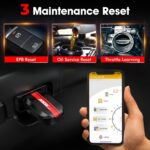Modern vehicles are equipped with sophisticated computer systems known as On-Board Diagnostics (OBD). These systems are crucial for monitoring vehicle emissions and various diagnostic parameters. For vehicle owners and automotive technicians alike, OBD systems offer significant advantages, enabling the early detection of potential issues before they escalate into major problems. When a fault is identified, the OBD system provides valuable insights into the problem’s nature, often including a snapshot of the conditions present when the fault occurred. Beyond fault detection, OBD systems also deliver real-time data from vehicle sensors, allowing users to monitor metrics such as speed, engine RPM, and torque, and to calculate important information like fuel efficiency.
OBDII systems, a standardized evolution of OBD, feature a 16-pin diagnostic connector, typically located within easy reach on the driver’s side, beneath the steering wheel. Accessing your vehicle’s OBDII computer system requires a specialized piece of equipment known as an Obdii/eobd Car Diagnostic Tool, often referred to as a scan tool. These tools bridge the gap between you and your vehicle’s onboard computer, allowing you to read and interpret diagnostic data.
OBDII/EOBD car diagnostic tools come in two primary forms: standalone devices and PC/Mobile-based systems. Standalone scan tools are self-contained handheld units that operate independently of other devices. While convenient, they often have limitations in terms of functionality, lacking advanced diagnostic capabilities and software upgrade options, despite potentially carrying a higher price. In contrast, PC/Mobile-based OBDII/EOBD car diagnostic tools leverage the processing power and versatility of computers and mobile devices. These systems require software to be installed on a laptop, smartphone, or tablet, which then communicates with a small OBD adapter plugged into the vehicle. Connection methods include USB, Bluetooth, or Wi-Fi. PC/Mobile-based tools offer greater flexibility, enhanced features, and are readily upgradeable, making them a powerful and cost-effective solution for comprehensive vehicle diagnostics.

